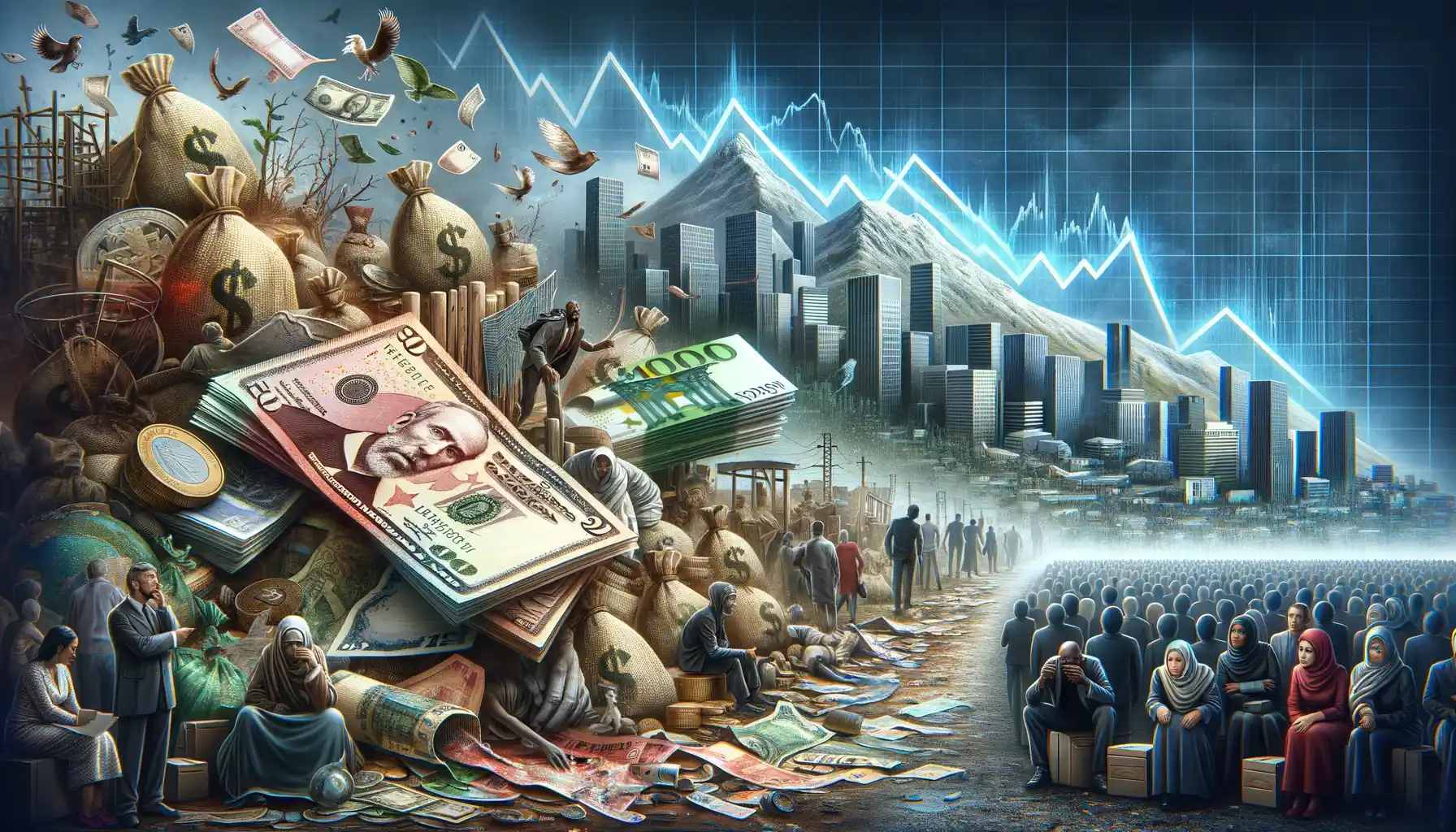Understanding Currency Devaluation and Its Causes
Unraveling the Mystery Behind Currency Devaluation
Imagine waking up to find that the money in your wallet doesn’t stretch as far as it used to. That’s currency devaluation—a drop in a country’s currency value compared to others. It’s like watching your purchasing power slowly melt away, one paycheck at a time. But why does this happen?
There’s no single villain here—it’s more like a group effort of economic complexities. Some key drivers include:
- Inflation: When domestic prices soar but wages don’t keep up, your currency loses its flavor on the global playing field.
- Trade imbalances: Importing way more than exporting can flood the market with your currency, tanking its value.
- Political instability: Uncertainty doesn’t just shake people—it sends currencies tumbling too.
How Global Forces Push Currencies Off Balance
Big players like international markets and foreign exchange rates also have a say in this delicate dance. If investors lose confidence in a nation’s economy, they’ll pull out faster than a sprinter at the starting line. And once they leave? The currency feels the heat.
It’s not just numbers on a screen; it impacts real lives. Think of families struggling to afford imported essentials or governments wrestling with ballooning debt. Devaluation isn’t just economic jargon—it’s a ripple through every household and business.
Economic Consequences of Currency Devaluation

How Devaluation Ripples Through the Economy
When a currency loses value, it can feel like the ground beneath a country’s economy is shifting. Picture this: a loaf of bread you bought last month just doubled in price, and your paycheck suddenly seems to vanish into thin air. This isn’t an isolated inconvenience—it’s a domino effect that impacts businesses, governments, and households alike.
For starters, imported goods become painfully expensive. Why? Because countries need more of their now-weakened currency to buy the same items from abroad. Imagine healthcare systems scrambling to purchase critical medical equipment priced in U.S. dollars or euros. The result? Skyrocketing costs for essential tools and medications.
And that’s just the beginning. Let’s talk debt. If a country owes money in foreign currencies, devaluation can turn manageable repayments into insurmountable burdens. Suddenly, funds that could go toward schools, hospitals, or roads are funneled into debt payments instead.
- Weakened industries may struggle to import raw materials—think pharmaceuticals or surgical supplies.
- Inflation surges, eating away at salaries and reducing purchasing power for everyday essentials.
It’s not just abstract numbers—it’s families, businesses, and entire healthcare systems caught in the storm.
Effects on Healthcare Funding and Resources

Why Healthcare Budgets Feel the Pinch
Picture this: a country facing currency devaluation, where money simply doesn’t stretch as far as it used to. That stretched-out devaluation ripples through every sector, but nowhere does it hit harder than in healthcare. Why? Because healthcare budgets aren’t elastic—they snap under pressure.
Governments and organizations suddenly find themselves scrambling to cover rising costs of imported medical equipment, vaccines, and even basic drugs. Imagine paying double for the same heart monitor you bought last year simply because your currency is worth less. Those dollars (or pesos, or francs) can no longer buy the same lifesaving tools, slashing available resources.
- Hospitals face stalled construction projects due to skyrocketing material import costs.
- Research funding evaporates as grants are eaten up just keeping the lights on in labs.
- Wage increases for healthcare workers fall behind inflation—doctors and nurses are left financially gasping for air.
The Human Side of Financial Constraints
Think about a rural clinic. Once brimming with vaccines and medications, now half-empty shelves greet patients. A mother seeking antibiotics for her child’s infection? Sent home empty-handed. Rising supply costs mean stockpiles dwindle faster than they can be replenished.
For many families, out-of-pocket costs skyrocket too. When governments cut public health funding under financial strain, individuals become their own safety net. But you can’t buy medicine when groceries already swallow half your income. This reality hits hardest for low-income households, who already juggle survival on an unforgiving tightrope.
Isn’t it ironic that in times of economic downturn, the very system designed to protect lives ends up gasping for resources itself?
Challenges for Medical Supply Chains and Access to Care

Disrupted Supply Chains: A Race Against Time
Imagine this—your local pharmacy, usually brimming with everything from antibiotics to syringes, now has more empty shelves than medicines. This is no exaggeration; it’s the stark reality faced by regions struck by currency devaluation. When a country’s currency plummets in value, importing medical supplies becomes an uphill battle. Negotiating with foreign suppliers suddenly feels like trying to stretch a shoestring into a rope—it just won’t hold.
Logistical nightmares add fuel to the fire. Limited foreign reserves mean fewer resources to pay for transportation, warehousing, and customs clearance. The result? Supplies arriving late, if at all. Essential items like vaccines, surgical gloves, and even insulin can become luxuries rather than necessities.
- Lifesaving medications: Prices can skyrocket overnight, shutting out vulnerable populations.
- Diagnostic tools: Hospitals may lack access to basic testing equipment, delaying critical diagnoses.
- Specialized machines: Imagine an ICU without functioning ventilators or dialysis units—it’s a grim picture.
The Human Toll: Barriers to Accessing Care
For patients, the ripple effects are devastating. Picture María, a single mother in rural Argentina needing monthly insulin for her diabetes. Now, not only has the price of insulin tripled, but the clinic nearest her home no longer stocks it. When people have to choose between food or medication, healthcare transforms from a human right into a distant dream.
Even public health systems struggle to keep services afloat. Clinics in low-income areas might see overcrowded waiting rooms because staff shortages become the norm when salaries depreciate in value. And who can blame them for leaving? After all, skilled professionals must also feed their families.
It’s a modern tragedy that needs immediate attention.
Strategies to Mitigate the Impact on Healthcare Systems

Innovative Funding Solutions for Health Systems
When a country’s currency loses its value, funding for healthcare can feel like trying to fill a bucket with a crack in it—it’s never enough. That’s where creative thinking comes in. Governments and organizations must find ways to stretch every dollar (or peso, or rupee).
One option? Public-private partnerships. These partnerships can inject much-needed cash into strained systems, enabling hospitals to buy equipment or hire staff. Imagine a tech company helping fund telehealth platforms in exchange for tax breaks—it’s a win-win.
Another strategy is embracing cost-sharing models. Yes, it’s tricky to ask patients to cover more during tough times, but scaling payments based on income ensures fairness. It means that no one misses care, even when the economy wobbles.
- International aid grants: Tapping into global healthcare funds can stabilize wavering budgets.
- Streamlined procurement systems: Cutting red tape ensures money isn’t wasted on inflated prices for essential drugs.
Empowering Local Communities to Build Resilience
Sometimes, the solution isn’t top-down but grassroots. Empowering communities to step up can be transformative. Think village clinics run by trained locals or small-scale pharmacies sourcing medicines directly from manufacturers to cut costs.
Health education plays a starring role here too. If people know how to prevent illnesses—like basic handwashing to stop infections—that reduces overall demand on a stretched system. Plus, micro-saving schemes help families plan for small healthcare expenses without fear of financial ruin.
In hard times, resilience comes from both innovation at the top and action at the ground level.
